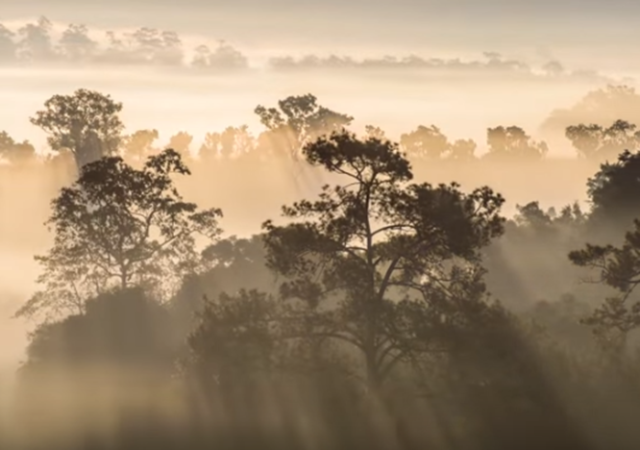New “Climate” Study Predicts Destruction of the Amazon Rainforest by 2064
The root cause of the concern may be Brazil’s plans for prosperity and development.

One of the favorite targets of the climate-change doom-and-gloomers has been the Amazon rainforest, the so-called “lungs of the Earth.”
Now, a new assessment published by a University of Florida professor predicts the rainforest will become a dry, scrubby plain by 2064 because of climate change and deforestation.
That forecast, published online in the journal Environment, gives the most specific date yet for the general demise of the Brazilian ecosystem, according to scientists familiar with Amazonian research.
The article, Collision Course: Development Pushes Amazonia Toward Its Tipping Point, was written by Robert Walker, a professor on the faculty of the university’s Center for Latin American Studies, who describes himself as a land change scientist.
“The best way to think of the forest ecosystem is that it’s a pump,” Walker told UPI. “The forest recycles moisture, which supports regional rainfall. If you continue to destroy the forest, the rainfall amount drops … and eventually, you wreck the pump.”
Walker predicts a veritable “climate catastrophe.”
He added that the local people’s dependency on the Amazon as a source of water means ‘the magnitude of the catastrophe will be worse than heretofore imagined’ in, at the very most, 44 years’ time.
…’It is doubtful that the Amazonian forest will remain resilient to changes in the regional hydroclimate,’ he writes.
‘The biggest concern involves intensification of drought-based tree mortality stemming from the synergies of fire, deforestation, and logging.
‘The development of Amazonia now lies on a collision course not only with the interests of conservation but also with the welfare of the very people it is meant to benefit.’
Interestingly, climate-disaster predictions are rolled-out to occur long after professors who publish such studies retire and after politicians who enact regulations based on politicized science have long left office.
As a reminder, Glacier National Park had to remove its “Gone by 2020” signs, as the glaciers had clearly survived the “catastrophe of global warming.”
The reason for the fear-mongering? Brazil’s proactive and capitalism-supporting president is keeping his promises to develop his nation.
Brazilian activists have voiced alarm over their government’s plans to bulldoze a 94-mile highway through a biodiverse corner of the Amazon along the border with Peru that is home to at least three indigenous communities.
The planned road is an extension of the BR-364, a 2,700-mile highway that links São Paulo with the Amazon state of Acre, and would connect the town of Cruzeiro do Sul with the Peruvian border town of Pucallpa.
Backers of the “transoceanic” project, who include Brazil’s president, Jair Bolsonaro, argue it will boost the economy of this remote region by creating a transport hub through which agricultural products can be shipped to Pacific ports in Peru and on to China.
“This project won’t destroy the forest, it will bring sustainable development to the region by heating up commercial and cultural relations [with Peru],” said Mara Rocha, a centre-right congresswoman from Acre who supports the idea.
One last note: An 8-mile-long “canvas” filled with ice age drawings of mastodons, giant sloths, and other extinct beasts was discovered in the Amazon rainforest, showing that the nature of the area has a long history of climate change.
The gorgeous art, drawn with ochre — a red pigment frequently used as paint in the ancient world — spans nearly 8 miles (13 kilometers) of rock on the hills above three rock shelters in the Colombian Amazon, a new study finds.
“These really are incredible images, produced by the earliest people to live in western Amazonia,” study co-researcher Mark Robinson, an archaeologist at the University of Exeter, who analyzed the rock art alongside Colombian scientists, said in a statement.
And while I will be a bit too old to opine in 64 years, I project that progressive professors in the future will continue to predict another man-caused catastrophe when this one fails to pan out.
 DONATE
DONATE
Donations tax deductible
to the full extent allowed by law.








Comments
If the left truly wanted to burn it all down, they’d stop with the climate change hysteria and just let the Earth reset. Instead, they want to conserve it. Wait, isn’t conservatism evil?
Just another scam by the left to gain power to loot and steal.
False concern for the environment has always been one of the favorite weapons of the left.
But the truth is that in today’s world the worst enemy of the environment is POVERTY.
Won’t it be easier to discover all the lost cities and pyramids that are currently hidden by vegetation?
This “climate debate” goes back to the 1820s. Every few years it changes and the dates are always just out of a life span or at least memory span.
.
Seems “rainforest” is the PC term for “jungle.” I’m hereby calling for a return to using the latter word.
Yes, exactly. And the PC word for “swamp” is “wetlands”.
Because carbon dioxide is *so* bad for vegetation…
Makes you wonder why “greenies” hate plants.
Conveniently, none of the prognosticators will be around in 2064 to be called out on yet another wrong climate prediction…
I disagree with their conclusions. I believe the jungle will last another 45 years (at least)
I don’t think there is any doubt that their is wide spread deforestation in the Amazon and that the current Brazilian gov has encouraged it. The debate about ‘gone by 2064’ is missing the point even if you move that date to 2090 or 2110 or whatever the trend is towards deforestation which is clearly a bad thing in context of removing carbon from the atmosphere, habits for species and other environmental benefits.
I note that the article supports the Brazilian gov position from a capitalism perspective. This is short sighted. The cost of climate change from factors such as sea level rises far out weight the benefits of increased land useage.